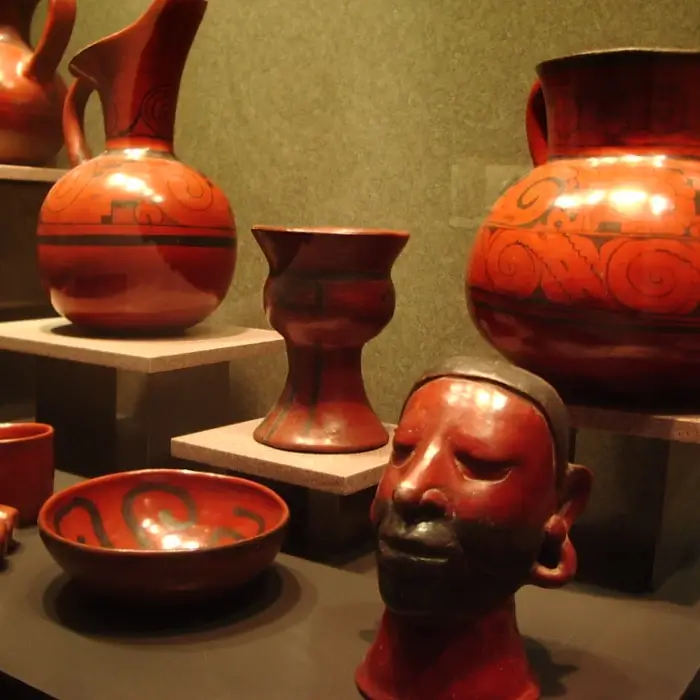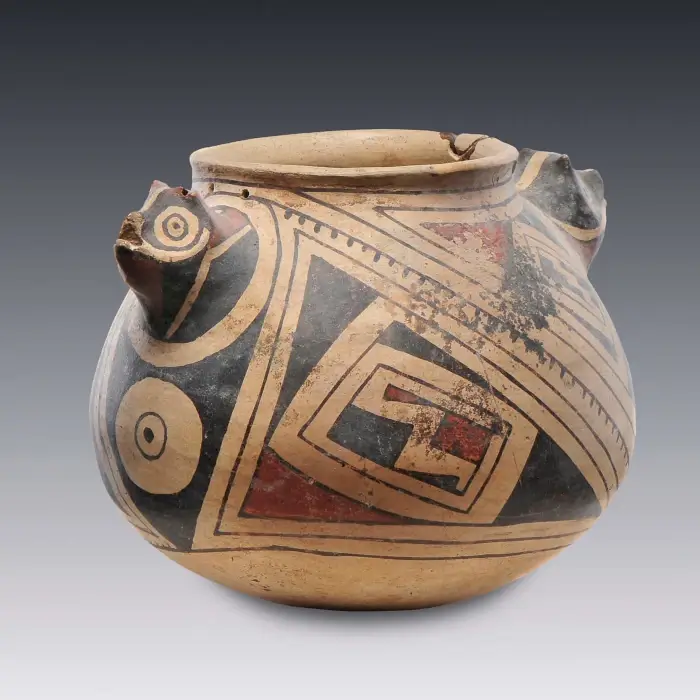Valdivia ceramics and its ancient culture
Valdivia pottery, originating from the Ecuadorian coast around 4000-3500 B.C., has left us some of the earliest representative images of the Americas. These pieces, both stone and ceramic, are characterized by their detailed workmanship, often reflecting both feminine and masculine attributes.
Although their exact purpose is uncertain, they are commonly interpreted as fertility figures, found mainly near domestic areas. This artistic legacy invites us to discover how these figures shaped the identity and beliefs of the Valdivia culture.

Origins and History of Valdivia Ceramics
The Valdivia culture, located in the Santa Elena peninsula in Ecuador, is one of the oldest settled civilizations in the Americas, dating between 3500 and 1800 BC. This culture is distinguished for being a pioneer in the use of ceramics in America, with pieces dating back to 2700 B.C. You can see its location on our map of pre-Columbian cultures.
These early sedentary and egalitarian societies lived in communities organized around central plazas, sustaining themselves through agriculture, fishing and, to a lesser extent, deer hunting.
Valdivia pottery, initially rudimentary and functional, evolved into more splendid and delicate forms, including vessels, jars and female figures that were used both in daily life and in religious ceremonies.
Valdivias Ceramics Production Process and Techniques
The ceramics of the Valdivia culture, recognized as one of the oldest of all ceramics in pre-Columbian America dating back more than 5,000 years, reflect a significant advance in manufacturing and artistic design.
The creation of these pieces not only marked a milestone in cultural development, but also involved a complex technical process, which evolved from simple forms to more sophisticated creations.
The female figurines, in particular, stand out for their detail and their possible association with agricultural and fertility rituals, suggesting a deep connection with the beliefs and daily life of Valdivia society.
The production process began with the selection and modeling of the clay, followed by careful decoration and finishing. The Valdivia pottery was then modeled, creating a variety of shapes of enigmatic beauty.
Some pieces were even painted with brightly colored engobes, showing a dexterity in the handling of ceramic techniques and materials. This level of skill indicates an advanced knowledge in the firing and treatment of the pieces, crucial aspects for the durability and aesthetics of the ceramics.
The variety in style and function of the pieces also suggests the existence of a commercial network and cultural exchange with other regions, which further enriched the diversity of Valdivia ceramics.
The analysis of its pieces not only offers us a glimpse into the technical innovation of the Valdivia culture, but also invites us to explore the complexities of its society, from everyday practices to ceremonial rituals. This ceramic legacy continues to inspire and provide valuable insights into early American civilizations and their evolution over time.
Uses and Functions of the Valdivia Ceramics
Predominantly, these ceramic pieces were used in agricultural rituals and ceremonies to invoke rain, evidencing a deep connection with nature and the subsistence of the community.
In addition, many of the female ceramic figures, known as ‘Venus de Valdivia’, are associated with fertility and agricultural development. These figures, often found near domestic areas, may have played a crucial role in rituals that sought to ensure the prosperity and well-being of the community. Their elaboration, from a single block of clay and with detailed finishes, reflects the cultural and spiritual importance of these figurines.
The Valdivia culture was also characterized by its maritime trade network, using rafts with sails to exchange products with Andean and Amazonian tribes. Among the objects traded, the use of the red Spondylus shell, often made into ornaments and considered more valuable than gold or silver, stood out. This exchange not only underscores the craftsmanship of Valdivia ceramics, but also its economic and social relevance within and outside the culture.
Symbolism of the Valdivia Culture in its Ceramics
The Venus of Valdivia, the famous female figures I mentioned before, had a possible role in agricultural rituals and ceremonies to invoke rain.
These female sculptures, characterized by their upright posture, pronounced feminine attributes and vivid facial expressions, were individually modeled from a single block of clay. Their workmanship included minute details such as elaborate hairstyles, indicating the importance of personal appearance and possibly social status within Valdivia society.

Attribution 2.0 Generic
Some figurines were painted entirely with red engobe, while others presented a bichromatic combination of red and the natural color of the clay.
This focus on the realistic representation of female figures, along with evidence of their participation in shamanic rituals, suggests that women may have had a central and powerful role within the Valdivia culture, which is reflected in the symbolism of this Andean pottery.
Legacy and Contemporary Relevance of Valdivia’s Ceramics
Ecuador’s Valdivia pottery, renowned for its antiquity and sophistication, has transcended the country’s archaeological sphere to become a symbol of American artistic and cultural innovation since its discovery in the 1950s.
The complexity of Valdivia iconography, with figures showing a mixture of zoomorphic and anthropomorphic characteristics, has generated comparisons with the sculptural work of renowned modern artists such as Constantin Brâncuşi and Henry Moore, highlighting how ancient artistic forms can influence and dialogue with contemporary art. This interaction demonstrates the ability of pre-Columbian art to cross temporal and cultural barriers, thus enriching the global art scene.
In addition, Valdivia ceramics reflect cultural and social practices of their time, such as agriculture and trade, underscoring the importance of understanding the past in order to understand the current dynamics of indigenous communities and their connection to the land and natural resources. This legacy, although threatened by the activity of looters and the creation of forgeries, remains a fertile field for research, offering new perspectives on the interconnectedness of cultures across the Americas and beyond.

Buy pre-Columbian ceramics
Find original pieces and also reproductions identical to the traditional ceramic works that were made in pre-Columbian America and that are only found in museums, making them affordable.
We hope you liked this post. It will help us if you share it on social networks .




